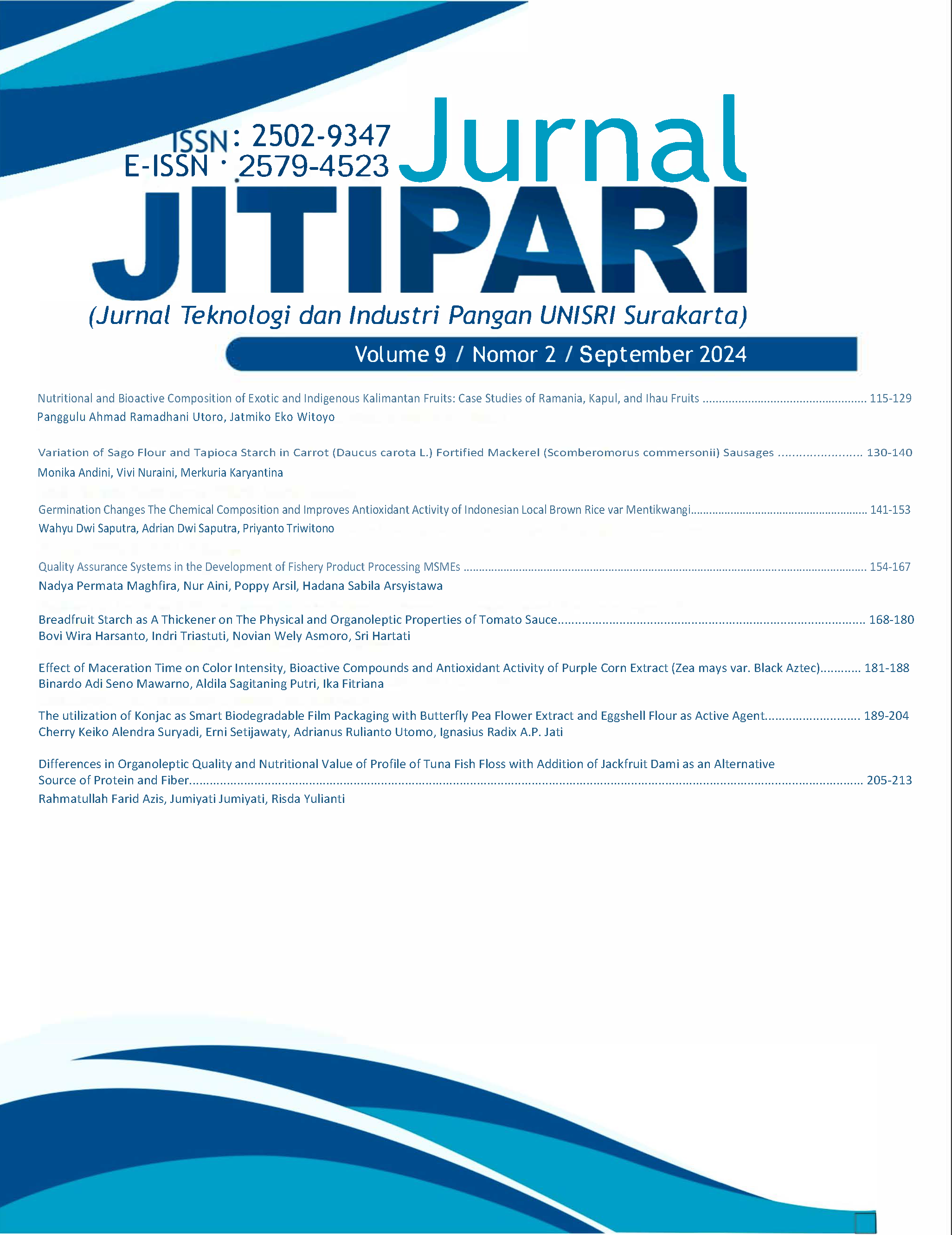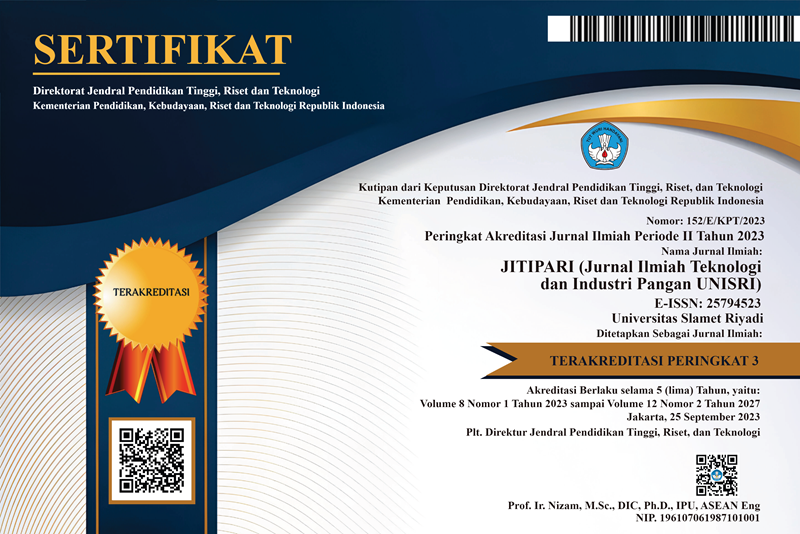Germination Changes The Chemical Composition and Improves Antioxidant Activity of Indonesian Local Brown Rice var Mentikwangi
Germinasi Merubah Komposisi Kimia dan Meningkatkan Aktivitas Antioksidan pada Beras Pecah Kulit Lokal var Mentikwangi
DOI:
https://doi.org/10.33061/jitipari.v9i2.10901Abstract
Previously, germination was reported in many studies that could improve the nutritional status and bioactive compounds in brown rice. However, the change of those functional properties was randomly different in diverse varieties. This study aimed to evaluate the change in chemical composition and functional properties of germinated brown rice from the Mentikwangi variety, one of the local paddy rice in Indonesia. Brown rice was germinated using the soaked and aeration method for 48 h. After that, the proximate compositions were analyzed including the change of total phenolic compounds and radical scavenging activity. We observed that germination in Mentikwangi brown rice significantly increased the crude protein content, but reduced the lipid and total carbohydrate contents. Moreover, the antioxidant activity was improved in germinated Mentikwangi brown rice sample due to the improvement of total phenolic compounds. These results affirm the previous studies which concluded that germination attenuated the functional properties of brown rice, so that has the potential to be developed as a future functional food.
References
AOAC, A. of O. A. C. (2000). Official Methods of Analysis.
AOAC, A. of O. A. C. (2006). Official Methods of Analysis.
Badan Pusat Statistik. (2022). Luas panen dan produksi padi di Indonesia 2023 (angka sementara) - Badan Pusat Statistik Indonesia. https://www.bps.go.id/id/pressrelease/2023/10/16/2037/luas-panen-dan-produksi-padi-di-indonesia-2023--angka-sementara-.html
Cáceres, P. J., MartÃnez-Villaluenga, C., Amigo, L., & Frias, J. (2014). Maximising the phytochemical content and antioxidant activity of Ecuadorian brown rice sprouts through optimal germination conditions. Food Chemistry, 152, 407–414. https://doi.org/10.1016/J.FOODCHEM.2013.11.156
Cevallos-Casals, B. A., & Cisneros-Zevallos, L. (2010). Impact of germination on phenolic content and antioxidant activity of 13 edible seed species. Food Chemistry, 119(4), 1485–1490. https://doi.org/10.1016/J.FOODCHEM.2009.09.030
Charoenthaikij, P., Jangchud, K., Jangchud, A., Piyachomkwan, K., Tungtrakul, P., & Prinyawiwatkul, W. (2009). Germination conditions affect physicochemical properties of germinated brown rice flour. Journal of Food Science, 74(9), C658–C665. https://doi.org/10.1111/J.1750-3841.2009.01345.X
Chinma, C. E., Anuonye, J. C., Simon, O. C., Ohiare, R. O., & Danbaba, N. (2015). Effect of germination on the physicochemical and antioxidant characteristics of rice flour from three rice varieties from Nigeria. Food Chemistry, 185, 454–458. https://doi.org/10.1016/J.FOODCHEM.2015.04.010
Guo, W., & Beta, T. (2013). Phenolic acid composition and antioxidant potential of insoluble and soluble dietary fibre extracts derived from select whole-grain cereals. Food Research International, 51(2), 518–525. https://doi.org/10.1016/J.FOODRES.2013.01.008
Hartati, S., Marsono, Y., Suparmo, S., & Santoso, U. (2017). Komposisi kimia serta aktivitas antioksidan ekstrak hidrofilik bekatul beberapa varietas padi. AgriTECH, 35(1), 35–42. https://doi.org/10.22146/AGRITECH.9417
He, D., Han, C., Yao, J., Shen, S., & Yang, P. (2011). Constructing the metabolic and regulatory pathways in germinating rice seeds through proteomic approach. PROTEOMICS, 11(13), 2693–2713. https://doi.org/10.1002/PMIC.201000598
Kim, H., Kim, O. W., Ahn, J. H., Kim, B. M., Oh, J., & Kim, H. J. (2020). Metabolomic analysis of germinated brown rice at different germination stages. Foods 2020, Vol. 9, Page 1130, 9(8), 1130. https://doi.org/10.3390/FOODS9081130
Komatsuzaki, N., Tsukahara, K., Toyoshima, H., Suzuki, T., Shimizu, N., & Kimura, T. (2007). Effect of soaking and gaseous treatment on GABA content in germinated brown rice. Journal of Food Engineering, 78(2), 556–560. https://doi.org/10.1016/J.JFOODENG.2005.10.036
Lin, Y. T., Pao, C. C., Wu, S. T., & Chang, C. Y. (2015). Effect of different germination conditions on antioxidative properties and bioactive compounds of germinated brown rice. BioMed Research International, 2015. https://doi.org/10.1155/2015/608761
Moongngarm, A., & Saetung, N. (2010). Comparison of chemical compositions and bioactive compounds of germinated rough rice and brown rice. Food Chemistry, 122(3), 782–788. https://doi.org/10.1016/J.FOODCHEM.2010.03.053
Munarko, H., Sitanggang, A. B., Kusnandar, F., & Budijanto, S. (2019). Kecambah beras pecah kulit : proses produksi dan karakteristiknya. JURNAL PANGAN, 28(3), 239-252–239 – 252. https://doi.org/10.33964/JP.V28I3.436
Munarko, H., Sitanggang, A. B., Kusnandar, F., & Budijanto, S. (2020). Phytochemical, fatty acid and proximal composition of six selected Indonesian brown rice varieties. CyTA - Journal of Food, 18(1), 336–343. https://doi.org/10.1080/19476337.2020.1754295
Munarko, H., Sitanggang, A. B., Kusnandar, F., & Budijanto, S. (2021). Germination of five Indonesian brown rice: evaluation of antioxidant, bioactive compounds, fatty acids and pasting properties. Food Science and Technology, 42, e19721. https://doi.org/10.1590/FST.19721
Nath, S., Bhattacharjee, P., Bhattacharjee, S., Datta, J., & Dolai, A. K. (2022). Grain characteristics, proximate composition, phytochemical capacity, and mineral content of selected aromatic and non-aromatic rice accessions commonly cultivated in the North-East Indian plain belt. Applied Food Research, 2(1), 100067. https://doi.org/10.1016/J.AFRES.2022.100067
Osborn D R, V. P. (1978). Calculation of calorific value. In: The Analysis of Nutrients in Foods. (pp. 239–240). Academic Press.
Pal, P., Singh, N., Kaur, P., Kaur, A., Virdi, A. S., & Parmar, N. (2016). Comparison of composition, protein, pasting, and phenolic compounds of brown rice and germinated brown rice from different cultivars. Cereal Chemistry, 93(6), 584–592. https://doi.org/10.1094/CCHEM-03-16-0066-R
Patil, S. B., & Khan, M. K. (2011). Germinated brown rice as a value added rice product: A review. Journal of Food Science and Technology, 48(6), 661–667. https://doi.org/10.1007/S13197-011-0232-4/TABLES/1
Pletsch, E. A., & Hamaker, B. R. (2017). Brown rice compared to white rice slows gastric emptying in humans. European Journal of Clinical Nutrition 2017 72:3, 72(3), 367–373. https://doi.org/10.1038/s41430-017-0003-z
Quettier, A. L., & Eastmond, P. J. (2009). Storage oil hydrolysis during early seedling growth. Plant Physiology and Biochemistry, 47(6), 485–490. https://doi.org/10.1016/J.PLAPHY.2008.12.005
Sompong, R., Siebenhandl-Ehn, S., Linsberger-Martin, G., & Berghofer, E. (2011). Physicochemical and antioxidative properties of red and black rice varieties from Thailand, China and Sri Lanka. Food Chemistry, 124(1), 132–140. https://doi.org/10.1016/J.FOODCHEM.2010.05.115
Supriyanti, A., Supriyanta, S., & Kristamtini, K. (2016). Karakterisasi dua puluh padi (Oryza sativa. L.) lokal di Daerah Istimewa Yogyakarta. Vegetalika, 4(3), 29–41. https://doi.org/10.22146/VEG.10475
Ukpong, E. S., Onyeka, E. U., & Oladeji, B. S. (2023). Bioactive compounds, nutrients and pasting properties of parboiled milled rice, brown rice and germinated brown rice of selected cultivars and the effects of germination durations. Food Chemistry Advances, 2, 100234. https://doi.org/10.1016/J.FOCHA.2023.100234
Watchararparpaiboon, W., Laohakunjit, N., & Kerdchoechuen, O. (2010). An improved process for high quality and nutrition of brown rice production. Food Science and Technology International, 16(2), 147–158. https://doi.org/10.1177/1082013209353220
Wu, F., Chen, H., Yang, N., Wang, J., Duan, X., Jin, Z., & Xu, X. (2013). Effect of germination time on physicochemical properties of brown rice flour and starch from different rice cultivars. Journal of Cereal Science, 58(2), 263–271. https://doi.org/10.1016/J.JCS.2013.06.008
Wu, F., Yang, N., Touré, A., Jin, Z., & Xu, X. (2013). Germinated brown rice and its role in human health. Critical Reviews in Food Science and Nutrition, 53(5), 451–463. https://doi.org/10.1080/10408398.2010.542259
Wu, N., Li, R., Li, Z. J., & Tan, B. (2022). Effect of germination in the form of paddy rice and brown rice on their phytic acid, GABA, γ-oryzanol, phenolics, flavonoids and antioxidant capacity. Food Research International, 159, 111603. https://doi.org/10.1016/J.FOODRES.2022.111603
Zhou, L., Lu, Y., Zhang, Y., Zhang, C., Zhao, L., Yao, S., Sun, X., Chen, T., Zhu, Z., Zhao, Q., Zhao, C., Liang, W., Lu, K., Wang, C., & Liu, Q. (2020). Characteristics of grain quality and starch fine structure of japonica rice kernels following preharvest sprouting. Journal of Cereal Science, 95, 103023. https://doi.org/10.1016/J.JCS.2020.103023
Downloads
Published
How to Cite
Issue
Section
License
Copyright (c) 2024 Wahyu Dwi Saputra, Adrian Dwi Saputra, Priyanto Triwitono

This work is licensed under a Creative Commons Attribution-ShareAlike 4.0 International License.
Authors who publish this journal agree to the following terms:
- Authors retain copyright and grant the journal right of first publication with the work simultaneously licensed under a Creative Commons Attribution-ShareAlike 4.0 International (CC BY-SA 4.0) that allows others to share the work with an acknowledgement of the work's authorship and initial publication in this journal.
- Authors can separately make additional contractual arrangements for non-exclusive distribution published by the journal (e.g., publish it in a book), with an acknowledgement of its initial publication in this journal.
- Authors are allowed and encouraged to send their work via online (e.g., in the institutional repositories or their website) after published by the journal.










